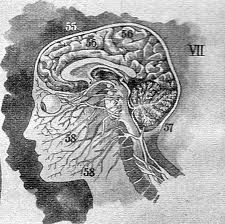
Andreas Vesalius came from a long line of Doctors, at the age of 17 he began medical studies at the University of Paris, he became bored of his teacher Sylvius, a firm believer in all of Galen's teachings and theories, because of his own knowledge acquired by previous experimentation.
I am aware that some context is needed here, it was in 1536 this all happened. Therefore there was reformation going on at every boundary and war was breaking out, Vesalius left Paris to study at the University of Louvain, near Brussels, Belgium.
.jpg) He got a chance to study a human body in detail - he stole a skeleton of a robber whose corpse had been pecked clean by the birds that was hanging in the gallows. Bit by bit he took it back to his room and wired together the full human skeleton, which he then learnt it in extreme detail.
He got a chance to study a human body in detail - he stole a skeleton of a robber whose corpse had been pecked clean by the birds that was hanging in the gallows. Bit by bit he took it back to his room and wired together the full human skeleton, which he then learnt it in extreme detail.Noticing the flaws between the skeleton he had and the teachings of Galen he was enraged to realise that Galen had based all of his teachings on animals, there was no evidence to indicate that Galen had ever actually seen the inside of a human. The sternum, I learnt, consists three parts; the manubrium, the body and the xiphoid process.
 Vesalius then came to the shocking conclusion that doctors treated humans based on the knowledge of apes.
Vesalius then came to the shocking conclusion that doctors treated humans based on the knowledge of apes. In 1537 he traveled to Padua to study further, the university there was Europe's most famous school, students ran the university and hired professors by vote. Vesalius got his medical degree on December the 5th 1537, the next day he was made professor of anatomy, because he was so popular his lectures became overcrowded and the students were unable to see the dissections properly, so Vesalius made illustrations, allowing the students to see at a glance what would take hours to explain.
I had a look at some the drawings by consulting a famous book created by Vesalius called 'De Humani Corporis Fabrica' (The Fabric of the Human Body), here are a few images from the book that contains detailed images of the human body, the muscles and the nervous system.
I thank you, once again for returning here, and welcome any newcomers, my page views have increased by a lot recently, I do believe I have some people from the USA reading this, I would really appreciate some comments and if there is anything you would like me to research a particular area of medicine or just science in general I would be willing to create a spin off blog.
Additionally, as sad as it is to confess, I have been given an essay to write for biology, specifically 'Why can't humans breathe underwater?' and I am extremely excited to finish researching it, because as simple as it sounds it is not such an easy answer, there is an extremely complex answer concerning many different aspects of science as a whole.
Thank you for reading, I will return soon, I am on my half term from school but have a very busy schedule, maybe one day I will be able to do nothing during a holiday, so goodnight my friends, I hope to see you soon.

No comments:
Post a Comment